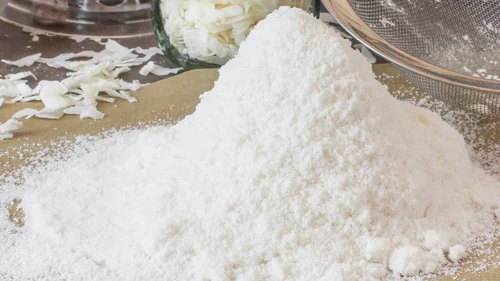Your Cart is Empty
FREE UK SHIPPING
24HR DISPATCH
FREE UK SHIPPING
24HR DISPATCH
FREE UK SHIPPING
24HR DISPATCH

Homemade coconut flour
Barb Hodgens
Barb Hodgens loves to cook with alternative, healthy whole food ingredients, with a focus on gut health. Barb has overcome her own gut health issues through healthy eating. Share your ideas, comments and photos at the end of this post :)

Nutritious, grain-free and low-carb flour.
Coconut flour is a gluten and grain free flour that is a fabulous addition to any baker’s kitchen, but it is especially popular in paleo, GAPS, SCD or keto diets because it is high in fibre and protein, low in carbohydrates, and naturally sweet.
The process for making coconut flour is different from other homemade flour methods we have shared on the Luvele life recipe blog. When coconut flakes are blended (or ground) the high-fat content quickly turns to coconut butter instead of flour. To achieve a dry flour consistency, coconut must have the milk and fats extracted first.
Making coconut flour at home is extremely cost effective, in fact, it’s practically free if you’re making coconut milk. Earlier this year we shared how easy it is to make fresh coconut milk at home in the Vibe Blender system. The natural by-product of coconut milk is coconut pulp – the fibre within the coconut meat. It is this left-over pulp fibre that is used to make coconut flour.
When you make homemade coconut milk it is worth saving the nutritious pulp fibre to make coconut flour. The left-over pulp from each batch of coconut milk can be stored in a sealed container in the freezer until you have enough to make a larger amount of flour.
The left-over pulp fibre must be dried out. This can be done in the oven or in a food dehydrator. If using a dehydrator, the trays will need liner inserts.

TIPS FOR BAKING WITH COCONUT FLOUR
Before you jump in and switch out your regular flour for coconut, there are a few unique characteristics that you should know about.
- Coconut flour can be used in both sweet and savoury recipes but while it is a versatile baking ingredient, it can be challenging to use. We recommend you begin using established coconut flour recipes before substituting coconut flour for any other baking flour.
- Coconut flour absorbs more water than any other flour and has the tendency to suck up moisture like a sponge. A very small amount of coconut flour will absorb a large amount of liquid. For this reason, you cannot substitute coconut flour on a 1:1 ratio. As a general rule, use a ¼ of a cup of coconut flour to every cup of (any other) flour.
- When baking with coconut flour, it is best to use an equal ratio of liquid to flour. For example, use ¼ cup of liquid for every ¼ cup of coconut flour.
- Another way to ensure you have enough liquid is to use plenty of eggs. Every ¼ cup coconut flour typically requires one egg for both moisture and structure.
- Coconut flour has a slight smell and taste of coconut but will not overpower your baking. It may be used as a stand-alone gluten-free flour but is best used in combination with other flours. Almond flour and coconut flour are delicious together. The addition of tapioca or cassava flour can also help as a binder.
- For crumbing and breading foods like pieces of meat or fish, you can typically use coconut flour as a 1:1 replacement.



Homemade coconut flour
Luvele
Rated 5.0 stars by 1 users
Coconut flour is a gluten and grain free flour that is a fabulous addition to any baker’s kitchen, but it is especially popular in paleo, GAPS, SCD or keto diets because it is high in fibre and protein, low in carbohydrates, and naturally sweet.
Ingredients
-
Coconut pulp (left over from making coconut milk)
Directions
- Set up your food dehydrator or line an oven tray with baking paper.
Turn the pulp out onto the tray (or liners)
Break the big clumps and spread the pulp evenly across the tray.
Place the tray in the oven on the lowest setting 60°C / 150°F for 3-4 hours or until it is completely dry.
- Remove from the oven and let sit until cold. It will have a light and airy texture.
Once the coconut pulp is cold, add it to the clear Vibe Blender jug. If you have prepared several trays, process the flour in batches. Blend no more than 1-2 cups at a time.
Choose ‘nut’ mode and blend for 30-50 seconds until you have the desired fineness.
Store the coconut flour in an air-tight container for up to 2 months or longer in the fridge or freezer.
Coconut flour may clump. Sifting is optional.
You might also like to try making almond flour, tiger nut flour or a variety of other gluten-free flour grains.
PIN THIS RECIPE

Homemade coconut flour

Nutritious, grain-free and low-carb flour.
Coconut flour is a gluten and grain free flour that is a fabulous addition to any baker’s kitchen, but it is especially popular in paleo, GAPS, SCD or keto diets because it is high in fibre and protein, low in carbohydrates, and naturally sweet.
The process for making coconut flour is different from other homemade flour methods we have shared on the Luvele life recipe blog. When coconut flakes are blended (or ground) the high-fat content quickly turns to coconut butter instead of flour. To achieve a dry flour consistency, coconut must have the milk and fats extracted first.
Making coconut flour at home is extremely cost effective, in fact, it’s practically free if you’re making coconut milk. Earlier this year we shared how easy it is to make fresh coconut milk at home in the Vibe Blender system. The natural by-product of coconut milk is coconut pulp – the fibre within the coconut meat. It is this left-over pulp fibre that is used to make coconut flour.
When you make homemade coconut milk it is worth saving the nutritious pulp fibre to make coconut flour. The left-over pulp from each batch of coconut milk can be stored in a sealed container in the freezer until you have enough to make a larger amount of flour.
The left-over pulp fibre must be dried out. This can be done in the oven or in a food dehydrator. If using a dehydrator, the trays will need liner inserts.

TIPS FOR BAKING WITH COCONUT FLOUR
Before you jump in and switch out your regular flour for coconut, there are a few unique characteristics that you should know about.
- Coconut flour can be used in both sweet and savoury recipes but while it is a versatile baking ingredient, it can be challenging to use. We recommend you begin using established coconut flour recipes before substituting coconut flour for any other baking flour.
- Coconut flour absorbs more water than any other flour and has the tendency to suck up moisture like a sponge. A very small amount of coconut flour will absorb a large amount of liquid. For this reason, you cannot substitute coconut flour on a 1:1 ratio. As a general rule, use a ¼ of a cup of coconut flour to every cup of (any other) flour.
- When baking with coconut flour, it is best to use an equal ratio of liquid to flour. For example, use ¼ cup of liquid for every ¼ cup of coconut flour.
- Another way to ensure you have enough liquid is to use plenty of eggs. Every ¼ cup coconut flour typically requires one egg for both moisture and structure.
- Coconut flour has a slight smell and taste of coconut but will not overpower your baking. It may be used as a stand-alone gluten-free flour but is best used in combination with other flours. Almond flour and coconut flour are delicious together. The addition of tapioca or cassava flour can also help as a binder.
- For crumbing and breading foods like pieces of meat or fish, you can typically use coconut flour as a 1:1 replacement.


:recipekit:
You might also like to try making almond flour, tiger nut flour or a variety of other gluten-free flour grains.
PIN THIS RECIPE

SUBSCRIBE
Sign up to get the latest on sales, new releases and more …
